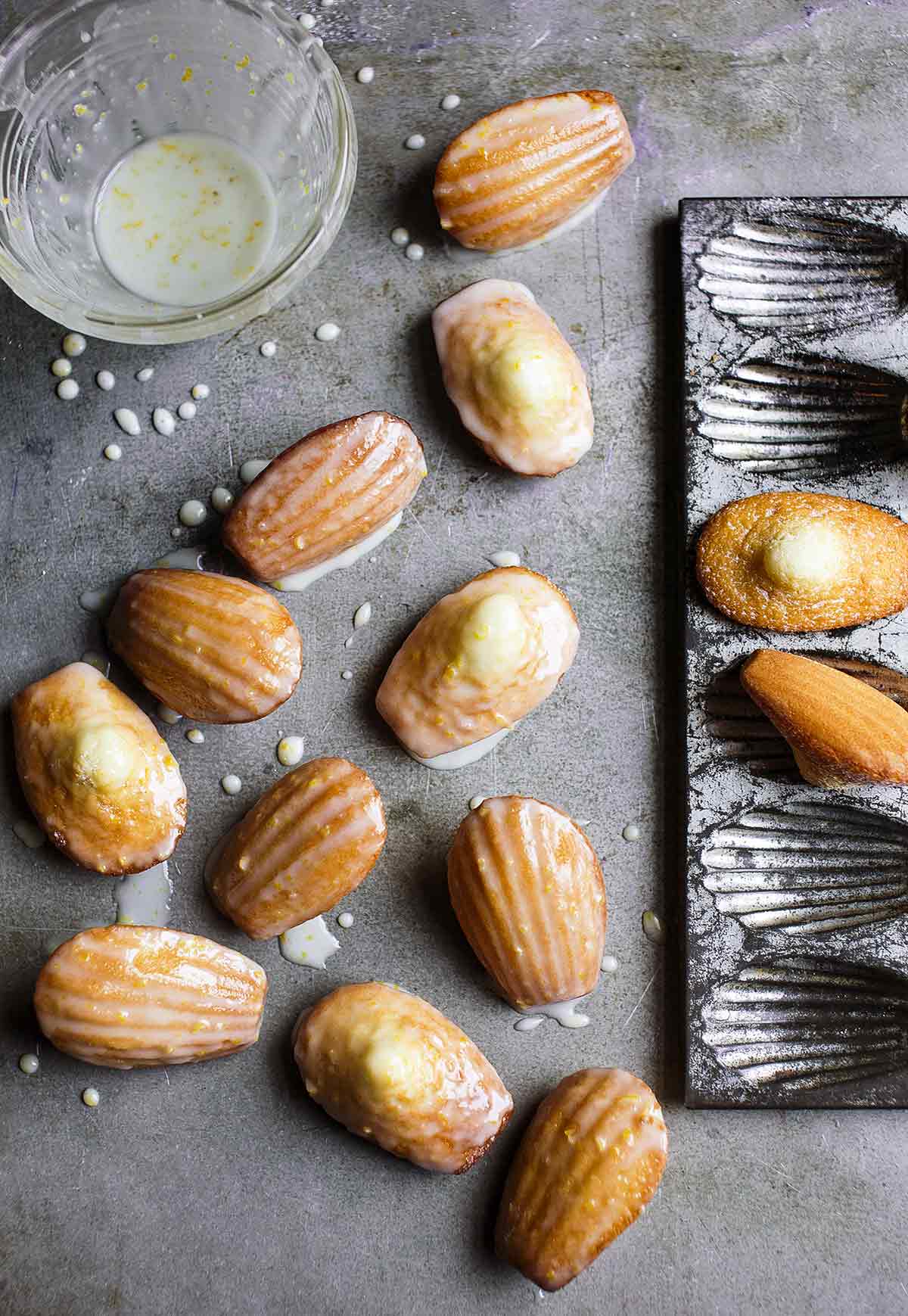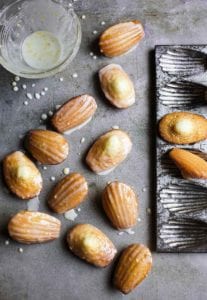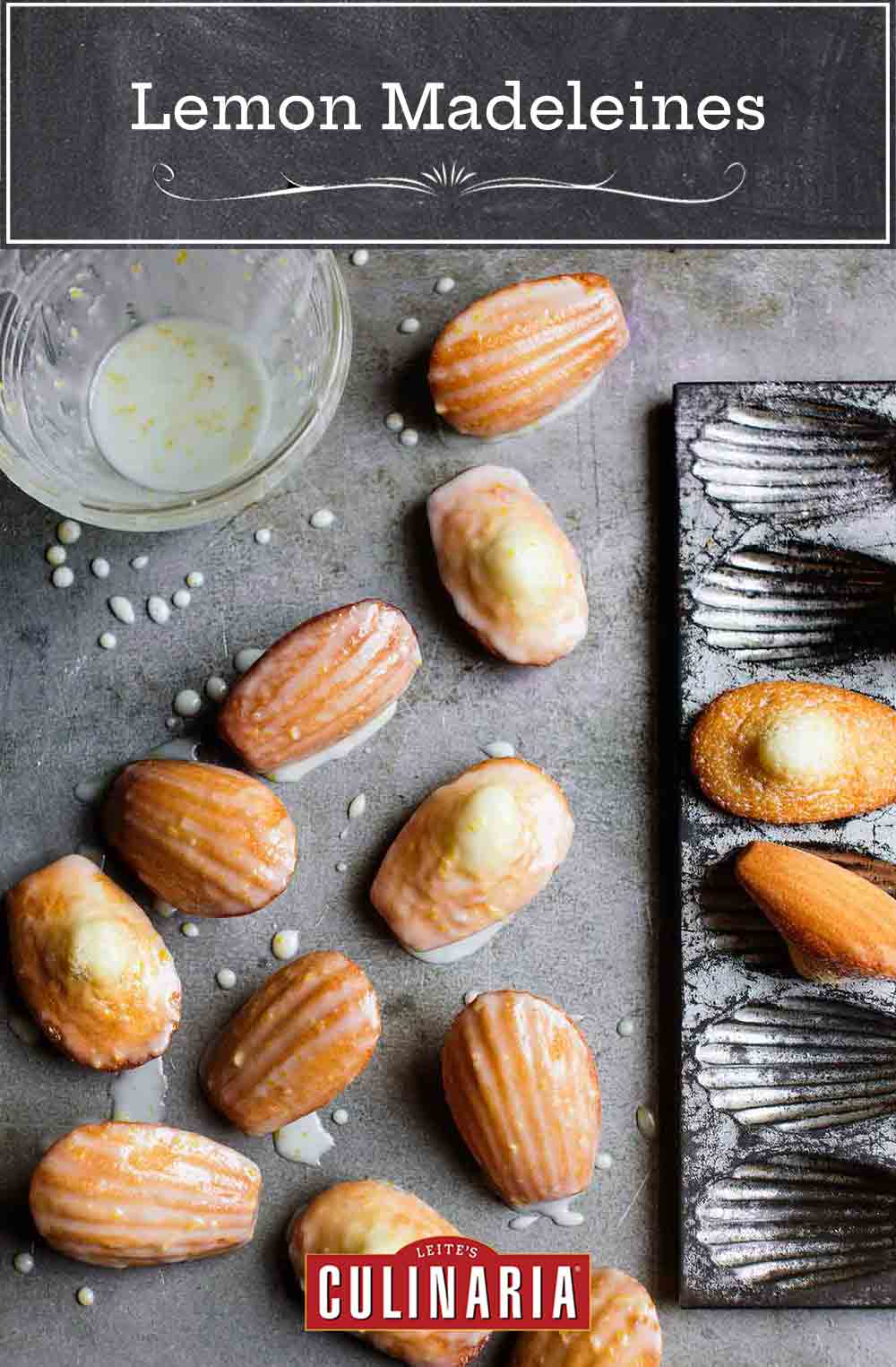
Let’s dispense with all the talk about Proust and the history of these lovely little tea cakes, shall we? Let’s instead just revel in the little-known fact that the batter for lemon madeleines can be stashed in the fridge for several days. Which means you can satisfy your craving in no time flat with freshly baked madeleines morning, afternoon, and evening.–Renee Schettler
HOW D0 I ENSURE PERFECTLY SHAPED MADELEINES?
To ensure your madeleines take on the lofty characteristic shape, you’ll want to make certain to do the following:
1. Refrigerate the batter for at least 3 hours. Also toss the madeleine pan in the freezer for an hour or so before baking.
2. Don’t overfill the mold, as this will obscure that classic hump shape.
3. And bake the madeleines at a relatively high temperature, as indicated in this recipe.

Lemon Madeleines
Equipment
- 2 full-size or petite madeleine pans (scallop-shaped is traditional)
Ingredients
For the madeleines
- 2 extra-large eggs (1/2 cup by volume)
- 1/2 cup superfine sugar, (or just blitz granulated sugar in a blender until finely ground but not powdery)
- 3/4 cup all-purpose flour, plus more for the madeleine tin
- 1 teaspoon baking powder
- 3 1/2 ounces unsalted butter, melted and slightly cooled, plus more for the madeleine tin
For the lemon glaze
- Zest and juice of 1 lemon, (1 scant tablespoon grated zest and a scant 1/4 cup juice)
- 1 cup plus 2 tablespoons confectioners’ sugar, sifted
Instructions
Make the madeleines
- In a large bowl with an electric mixer, beat the eggs and the sugar until thick and pale, about 6 minutes.
- In a separate bowl, whisk together the flour and baking powder. Sift 1/3 of the flour mixture over the egg mixture, using a spatula to carefully fold and combine. Then add the remaining mixture in 2 additions in the same fashion.
- Take a large spoonful of the batter and add this to a small bowl along with the butter, mixing them together to lighten the butter. Pour the butter mixture into the batter and gently fold together to combine. Press a sheet of plastic wrap directly onto the surface of the batter and then refrigerate for at least 3 hours before baking. (The mixture can, blissfully, be stashed in the fridge for up to 2 days at this stage.)
Make the lemon glaze
- In a medium bowl, use a spoon to mix together the lemon juice, zest, and confectiners’ sugar until you have a smooth, pourable glaze. Add more lemon juice or sugar as needed. Press a piece of plastic wrap directly onto the surface of the glaze and let stand at room temperature until needed.
Bake the madeleines
- About an hour before baking, butter a full-size or petite madeleine pan very well and dust with a little flour, tapping out any excess. Transfer the pan to the freezer to chill.
- Preheat the oven to 425°F (220°C). When you’re ready to bake, spoon the batter into the madeleine molds, being careful not to fill any of the molds more than 3/4 full. You don’t need to spread the batter, as this will happen in due course as the madeleines bake. Bake until the cakes are cooked through and the edges have started to brown, 8 to 10 minutes for full-size madeleines and 4 to 5 minutes for petite madeleines.
- Remove the pan from the oven and immediately turn the madeleines out onto a wire rack. Let cool for 10 minutes.
- Place the wire rack over a sheet of parchment paper. When the madeleines are cool, dip them into the glaze, coating them fully, letting the excess glaze to drip back into the bowl before placing the madeleines on the rack to set, about 20 minutes. These are best served as close as possible to coming out of the oven and are most spectacular the day they're baked.
Notes
Madeleine variations
Madeleines are really versatile. The author has flavored them in all sorts of ways, from mixing cacao nibs into the batter to using a blood orange glaze and even dipping them in tempered chocolate.Explore More with AI
Nutrition
Nutrition information is automatically calculated, so should only be used as an approximation.
Want to save this?
Recipe Testers’ Reviews
Oh, mes petites madeleines, how I adore you so. One of my favorite treats as a child was my mom’s madeleines. She used to make all kinds—the almond and orange ones were my favorite, covered in confectioners’ sugar. But funnily enough, I’ve never made madeleines myself. And come to think of it, my mom hasn’t made them in years, either. Thank goodness she still had her madeleine pan so I could test this recipe!
The Official Madeleine Taste Tester is my dad. He’s a madeleine connoisseur, and if he liked these, then I knew we had a winner. Once the treats were ready, I immediately drove over to my parents to get a verdict. And yes, to my delight, my dad’s exact words were, “You can continue to make these. These are the best I’ve ever had. Even compared to your mom’s.” Now if that isn’t an endorsement for a recipe, then I don’t know what is. Even my mom agreed.
I did leave some of the treats plain, just to taste the cakes without the glaze. They were delicious both ways, and when eating these without the glaze, the simplicity and buttery texture certainly came through. My dad preferred the lemon-glazed ones. I was pretty impressed myself. This recipe created the lightest, airiest, buttery, melt-in-your-mouth madeleines ever! This recipe is a new family favorite and Dad-approved—he’s already requested another batch. I can’t wait to take this base recipe and try new variations as well. Next time, I’d be inclined to add some zest to the batter to kick up the lemon flavor a bit.
What a fabulous lemon madeleine recipe! From the moment I saw this recipe, I couldn’t wait to make it. The technique sounded so intriguing and I thoroughly enjoyed the process of making these delectable little goodies. The proof of success is in the fact that they all disappeared from the glass cake dome I stored them in within 24 hours from the time I plated them on my kitchen counter! (Teenagers and friends and husband and myself are to blame.)
I absolutely loved seeing the transformation of the eggs and sugar in my stand mixer turn into the rich, creamy, pale yellow mixture come together in my stand mixer bowl, like alchemy in the kitchen. Folding in the flour and baking soda and eventually the butter were utterly therapeutic for me. But most of all, tasting the final result left me in pure bliss. I made half the lemon madeleines with the glaze and half without. Either way, these are great. The smell in the house was intoxicating. They puffed up beautifully and got that gorgeous dome. I’ll definitely use this recipe again.
I am a lemon lover! And even though the lemon is only in the glaze, it’s quite lemony. These delicate lemon madeleine are so very pretty and a perfect size. The madeleines turned out beautifully. They’re not difficult to make, but one needs to pay special attention to the folding of ingredients.
I let the batter sit overnight in the refrigerator and was surprised at the texture of the batter when spooning it into the madeleines pan. It was a little sponge-like, but then again, these are mini sponge cakes! There was a little batter left over. I beat the batter for 8 minutes, which worked out fine. The mixing of the glaze took just a few minutes. I baked them for 9 minutes. It took them about 20 minutes to set after dipping in the glaze.
Extended family was visiting and they loved these lemon madeleines. The batter baked up beautifully. The taste is great. The flavor ends up being strongly lemony due to the glaze. The baking time was accurate. The only issue is the yield—it made more than a dozen and I have a standard French madeleine pan.
I love these elegant little tea cakes, not just because they’re bite-size, sweet-looking, and always get a positive response, but also because they really can be made fresh and frequently with a little batter stashed in the refrigerator. (That trick must have been why the lovely young French wife and mother we met one day at an aquarium was so willing to share her madeleines—her lucky family got fresh ones every day.) Little did I know then that these are so easy to do yourself that they justify the special pans, and you don’t have to start from scratch every day.
I wrap the buttered and flour-dusted molds with plastic wrap so I can get them into the freezer at whatever jaunty angle is possible and not worry about disturbing the coated surface. While a spatula works fine for folding, I really preferred using a flexible flat silicone whisk because it folds gently and does a better job getting the sifted flour into the egg-sugar batter without over-mixing.
If you’re certain the madeleines will be consumed the day you make them, then glaze away, but if you think they may be eaten over a couple of days, I think they keep better unglazed. In that case, you could add a little citrus zest to the batter (I zested an orange over the melted butter before incorporating it into the batter on one batch). I’ve also learned that since your pan may not be the same size as the one used by the author, it’s worth prepping a spare pan. (I had a bonus of 1 dozen petite madeleines in addition to 12 full-size madeleines from this recipe.)
Do NOT overfill the pans—the batter will spread, so try filling no more than 3/4 of each mold. Trust me, it’s better to err on the side of under-filling the pans. They were ready to take out at 8 minutes in my oven and turned out easily onto a cooling rack. I made the glaze before putting them into the oven. My glaze was very pourable and slightly thin, but it set nicely. I used a bit less juice on the orange version. If you want a more obvious glaze, you’ll want to make it a little thicker. Try to not disturb them for plating or transport for half an hour. This is one of those wonderful French secrets, like chocolate mousse, that’s elegant AND easy!













Those are by far the best madeleines I’ve ever made. Texture is perfect and the lemon icing just takes it over the top. Thank you for this amazing recipe!!!
You’re so very welcome, Luda! Thank you for taking the time to let us know you love them as much as we do!